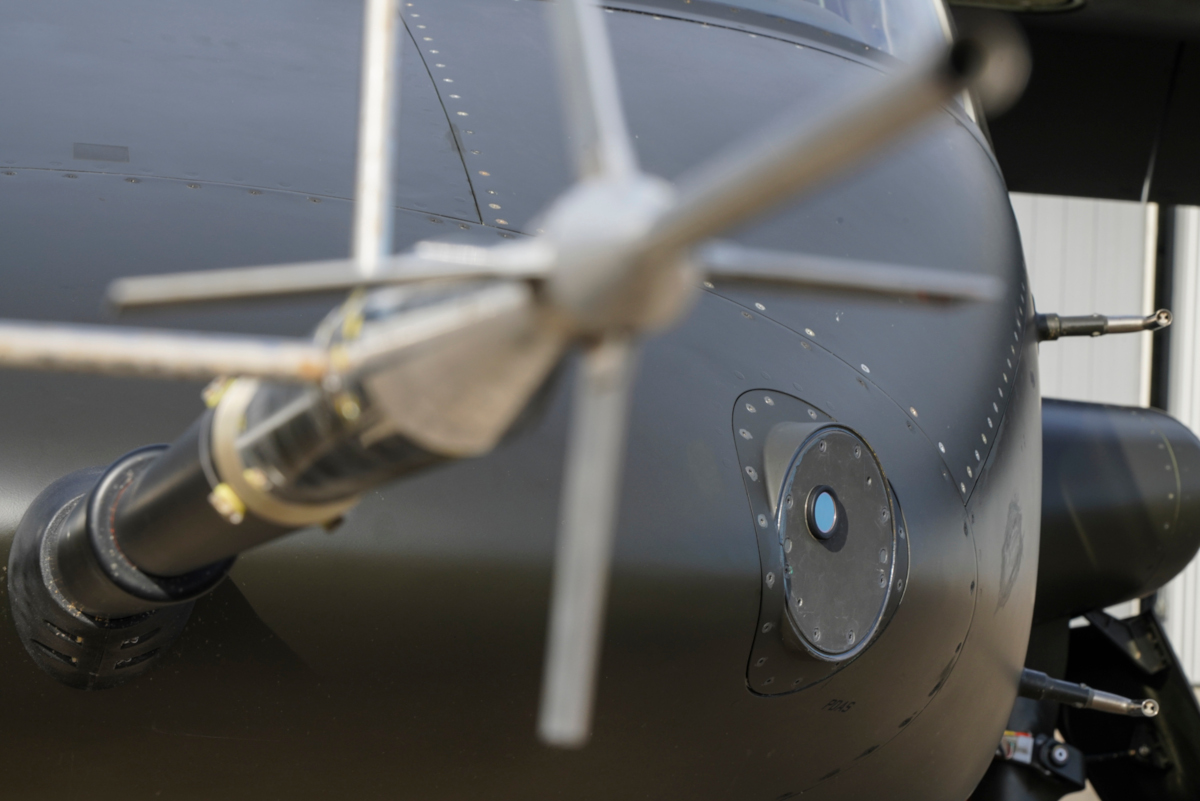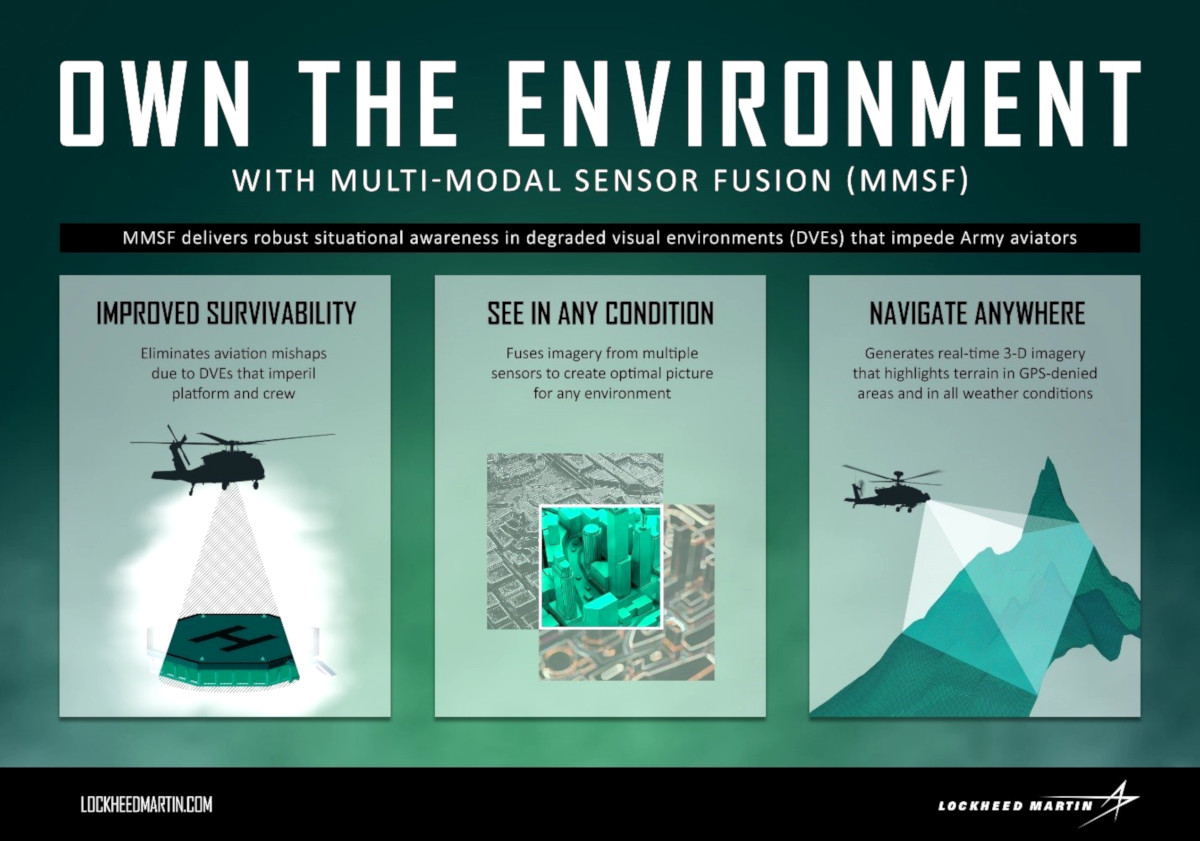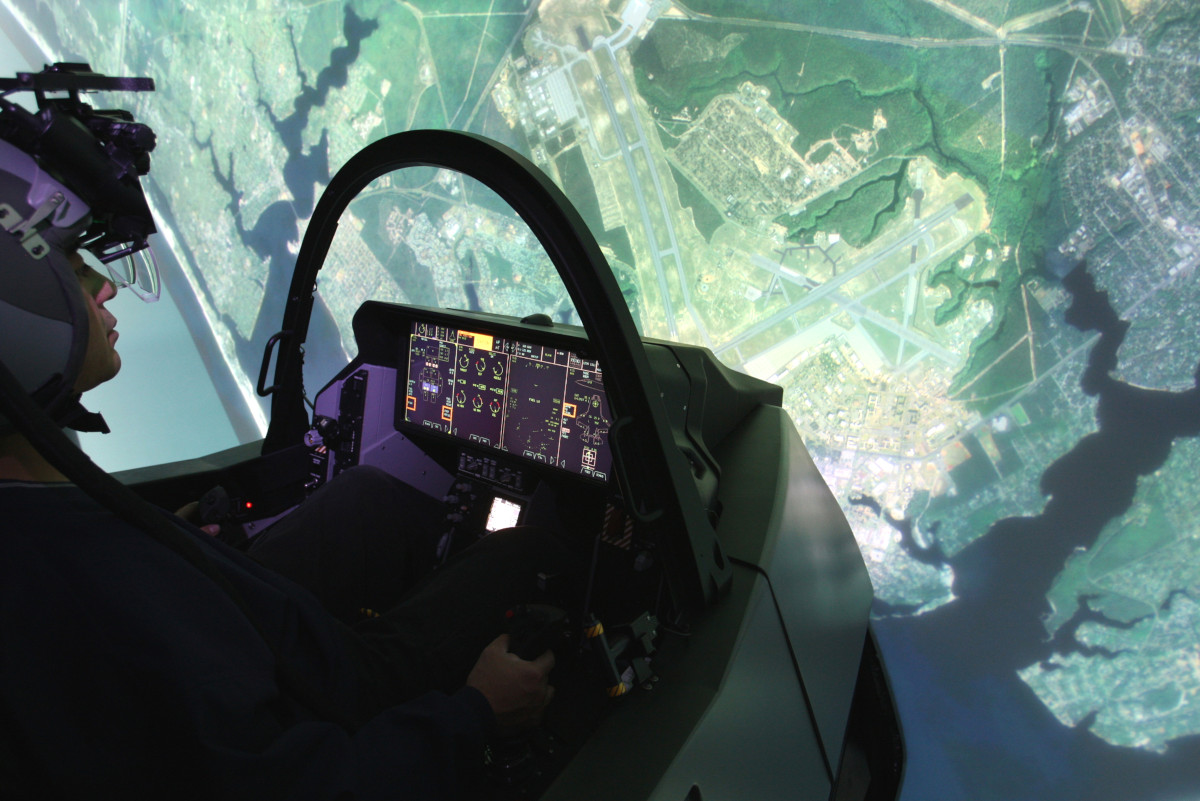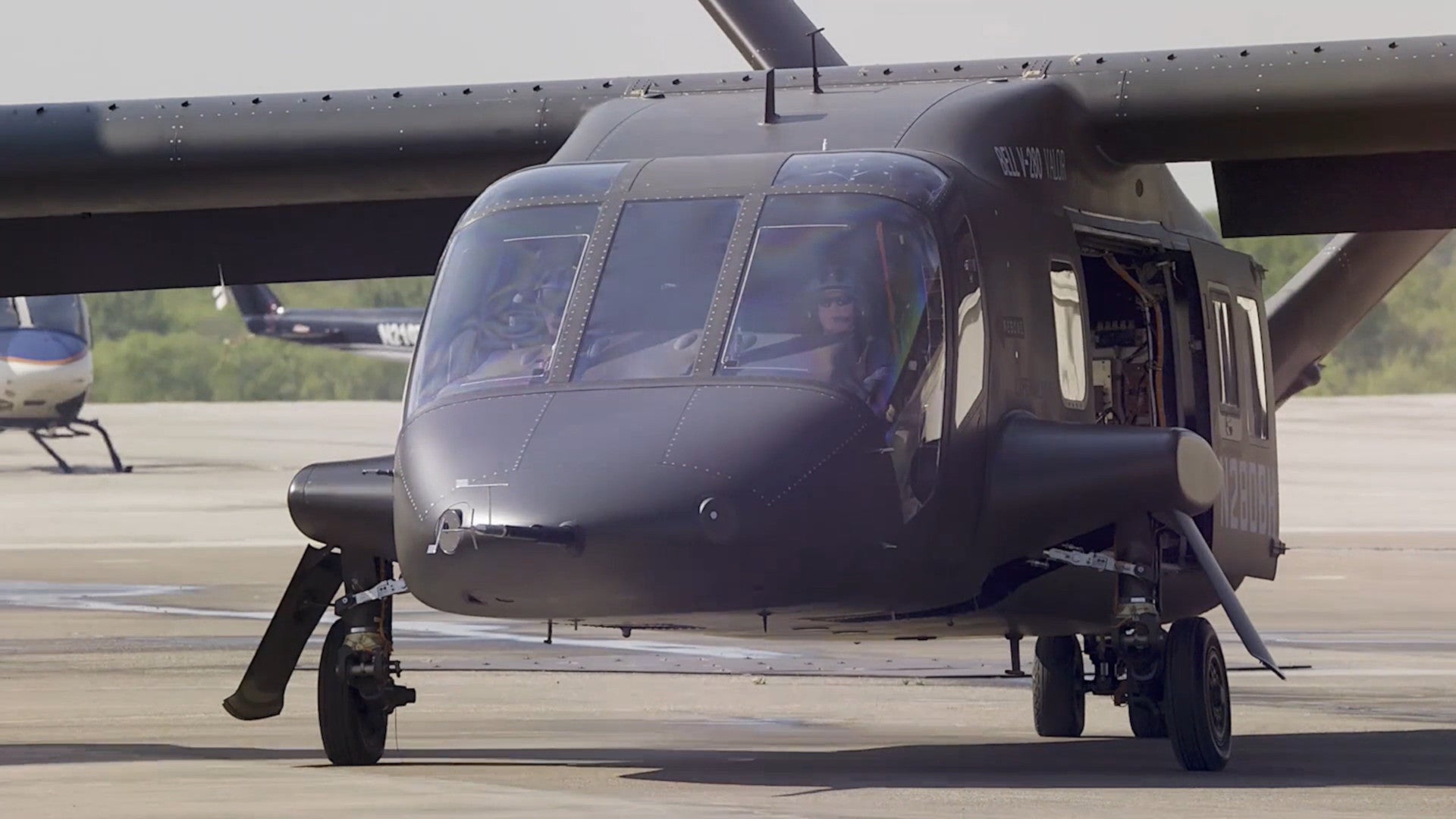Lockheed Martin has flown its new Pilotage Distributed Aperture Sensor, or PDAS, on Bell’s V-280 Valor tilt-rotor aircraft for the first time. This system uses multiple cameras to offer pilots a 360-degree view around their aircraft, similar to the Distributed Aperture System on the F-35 Joint Strike Fighter. This is a game-changing capability that could improve their ability to avoid threats, navigate more safely, even at night and in other poor visibility conditions, and simply have better situational awareness overall during flight. The modular technology could have applications far beyond tilt-rotors and other rotorcraft, including fixed-wing aircraft, ships, and ground vehicles, and might find uses in the commercial sector, too.
On Apr. 15, 2019, the Maryland headquartered defense contractor revealed that it had conducted the PDAS tests on the prototype V-280 in a series of flights from its facilities in Fort Worth, Texas the month before. Lockheed Martin says it signed a deal with Bell in 2013 to test the system on their tilt-rotor and began working on it actively in 2014. The company has previously tested it on board a UH-60 Black Hawk helicopter, as well.
“Conducting PDAS flight tests on the V-280 is an exciting first step toward delivering a level of situational awareness unavailable on today’s Army rotorcraft,” Rita Flaherty, the Strategy and Business Development Vice President at Lockheed Martin’s Missiles and Fire Control division, said in a press release. “With its embedded, multi-functional sensors, PDAS is the ideal foundation for an integrated survivability suite that will enable Army aircrews to own any environment and universally detect and defeat incoming threats.”
The PDAS configuration on the V-280 consists of six infrared cameras positioned around the aircraft. A central processing system “stitches together” these feeds and then pump them into helmet-mounted displays for the pilot and co-pilot, as well as fixed screens in the cockpit. The result is that pilots can “see” in any direction, including what would otherwise be blind spots, such as through the floor or straight to the rear of the aircraft.
This is similar in general principle to how the Northrop Grumman AN/AAQ-37 Distributed Aperture System (DAS) works on the F-35 Joint Strike Fighter. The DAS similarly gives pilots in these stealthy fighter jets a panoptic view in any direction.
Lockheed Martin’s PDAS presents a simpler, less deeply integrated option that is more applicable to helicopters and tilt-rotors, such as the V-280. The company started development of the system as something that could eventually work its way into the Army’s Joint Multi-Role (JMR) technology demonstration, which is supposed to lead into parts of the larger Future Vertical Lift (FVL) program.

FVL’s objective is to develop replacements for all of the Army’s existing helicopters, which could also supplant other rotorcraft in service across the U.S. military. As part of the JMR effort, the V-280 will take part in a series of evaluations alongside the SB>1 Defiant compound helicopter from Boeing and Sikorsky. Lockheed Martin bought Sikorsky in 2015, after work on the PDAS for Bell’s V-280 began.
The Army has tied both JMR and FVL to a variety of other tertiary efforts to develop advanced capabilities that are modular and adaptable to whatever design it might choose. PDAS is one of these related developments and one that could be especially revolutionary.
The video below includes clips from Lockheed Martin’s test of the PDAS-equipped V-280 in March 2019.

On its website, Lockheed Martin likens PDAS to the introduction of the Target Acquisition Designation Sight/Pilot Night Vision Sensor (TADS/PNVS) on the AH-64 Apache gunship. This nose-mounted sensor turret, which the Army has since replaced with the Modernized TADS/PNVS, offered then state-of-the-art capabilities that allowed crews to navigate and target opponents like never before at night. The service also coupled it with a helmet-mounted monocle that could both cue the sensors and display the feed right in front of the pilot’s eye.

Many helicopters now have their own sensor turrets to allow for improved target acquisition and navigation at night, during poor weather, in when operating in environments full of smoke, dust, or other obscurants. The Army itself has been working separately on a Degraded Vision Environment-Mitigation (DVE-M) camera system for its existing helicopters to make it easier and safer for them to operate in these conditions.

However, the majority of these systems generally offer a limited “soda straw” view in only one direction at a time. At night, aviators also use night vision goggles to provide additional situational awareness, but these also typically have a relatively narrow field of view. Even advanced systems coupled with helmet-mounted displays, such as t Apache’s TADS/NVDS, are still uni-directional, even though they do allow the crew to rapidly shift focus from a single area to another.
In contrast, PDAS gives pilots the ability to shift attention from one area of interest to another without having to slew a sensor turret, or physically move the aircraft into a more optimal position, at all. With this system, crew members can also look in different directions independently at once.
This means they can more rapidly identify targets or threats, including things such as incoming missiles. It also offers the possibility that the crew may be able to more readily spot and avoid hazards altogether and could make formation flying safer.
PDAS’ situational awareness is also important just for basic navigation, especially at night and when flying low-level nap-of-the-earth flight profiles. At low altitudes and high speeds, helicopters and other rotorcraft as particularly vulnerable to a host of general environmental hazards, including power lines. These risks only go up after dark or when various visual obscurants are present, all of which can cause sudden and dangerous losses of situational awareness.
This could also help during missions that require helicopters and other rotorcraft to hold a steady hover for a protracted period of time, while also winching personnel or other cargo up and down, such as combat search and rescue or disaster relief. These operations can often occur in areas where there is limited room to maneuver, requiring the entire crew to be constantly aware of their position. The same goes for trying to land or insert personnel into very tight spots.

Lockheed Martin has also designed the PDAS to readily accept upgrades to add more features in the future, too. The hope is that a single system could provide enough processing power to pump feeds into up to six helmets on a single helicopter or tilt-rotor. This means door gunners or other personnel would have the same augmented vision, provide even greater situational awareness for the crew and their passengers, as a whole.
Together with what the company calls Multi-Modal Sensor Fusion (MMSF), PDAS could eventually overlay information from other sensors to provide an even more comprehensive picture with a symbology that identifies friendly forces, threats, and other objects of interest. Information from multiple sensors would also help mitigate a failure of any one particular system, either from hostile attacks or general malfunctions.
For instance, Lockheed Martin says that terrain-following and terrain-recognition capabilities could provide an important, accurate navigation capability even in an instance where an opponent is jamming GPS signals, something that is becoming an increasingly realistic threat on the battlefield. Sikorsky has also been working separately with the Army and the Defense Advanced Research Projects Agency (DARPA) to develop a “digital co-pilot” system that can use a series of cameras and other sensors fly a helicopter autonomously, if necessary. You can read more about this program, known as the Aircrew Labor In-Cockpit Automation System (ALIAS), which aims to help aircrews perform a wide array of tasks more safely and efficiently, here.

Lockheed Martin says it expects to demonstrate PDAS on an M-model Black Hawk helicopter for an unspecified “special customer” this summer, too, according to Defense News. This could very well be Army’s elite 160th Special Operations Aviation Regiment, which operates almost exclusively at night and in challenging and unusual environments where the added situational awareness the system offers could be particularly useful.
But the value of the capabilities PDAS has to offer is hardly limited to helicopters and other rotorcraft. It could be adaptable to various fixed-wing aircraft, such as cargo planes and aerial refueling tankers, that might not need something as robust as the F-35’s DAS, but still have requirements to operate at night and in other visually degraded environments where improved situational awareness could be extremely valuable.
It could also be a revolutionary upgrade for flying unmanned aircraft remotely. At present, drone operators have extremely limited situational awareness since the only way they can “see” what’s around the aircraft is to use its onboard sensors. PDAS would give these remote pilots not only a virtual cockpit, but one with completely unrestricted vision. Even with future fully autonomous unmanned combat air vehicles, a physical individual could use this system to monitor the drone’s progress and then take control directly if necessary. It could be especially useful for using advanced drone for more complex missions, such as close air support, that would benefit from a man-in-the-loop control with high situational awareness. Of course, all this is limited by communications bandwidth capable of pumping out so much data beyond line-of-sight.

Systems such as PDAS offer many of the same advantages to the crews of ships and ground vehicles, as well. This would similarly apply to manned and unmanned platforms, too.
For example, the existing electro-optical and infrared camera systems on ships have similar limitations to sensor turrets on aircraft. In some cases, the maritime systems are virtually identical to their aerial counterparts. PDAS, or a system like it, would let the crew on a ship “see” through the hull or personnel inside an armored vehicle “look” straight through the hull.
In a maritime setting, this could make it easier to spot smaller threats, such as swarming of suicide boats very low to the waterline, or environmental hazards, such as shallow rock outcroppings. Northrop Grumman has already been working on a navalized version of the AN/AAQ-37, known as Silent Watch.
For ground vehicles, it would mean being able to maintain full situational awareness even “buttoned up” with all the hatches closed, offering maximum protection against the enemy. Historically, this has meant severely limiting the vision of the vehicle’s occupants, which could open up blind spots to attack, especially in dense urban areas where hostile forces can easily pop out from behind cover, engage their targets, and then rapidly withdraw to safety.
In 2018, Israeli defense contractor Elbit unveiled Iron Vision, an augmented reality vision system for armored vehicles. Rafael, another Israeli firm, is also now pitching its own suite of networked sensors, claiming it can readily adapt the modular system to different vehicles.


The advantages of a distributed vision system such as PDAS are readily applicable to various commercial sectors, as well. On the aviation side, aerial fire fighting helicopters and fixed-wing aircraft would be among the most immediate beneficiaries of an augmented vision system.
These fixed- and rotary-wing aircraft, by definition, are flying at low level in areas full of smoke that can be dense enough to limit visibility and the amount of natural light available during the day. Again, the potential risks only increase after dark, which has led many jurisdictions to severely limit nighttime aerial firefighting operations.
PDAS or an equivalent could make it safer and easier for aerial firefighting aircraft to conduct their missions, especially at night, when temperatures drop, humidity goes up, and winds often die down, making it an optimal time for water bombing sorties. The video below looks at testing in Australia in 2018 to validate night aerial firefighting capabilities, which explores many of these issues in more detail.

As seen in the video above, night vision goggles are the primary means of enabling nighttime aerial firefighting operations now. The same goes for many police helicopters, air ambulances, and other aircraft supporting first responders after dark. Sensor turrets are becoming more commonplace, but still have the limitations discussed earlier.
All of these aircraft could benefit from something such as PDAS, especially if they have to weave through dense urban environments. Civilian agencies and contractors flying in humanitarian assistance in the wake of a major disaster or other crisis would definitely appreciate the added situational awareness. It could be invaluable in cases where existing airfield lighting and other infrastructure might be severely damaged, if it wasn’t very limited, to begin with.
A number of private companies are looking at ways to make inter-city air travel a more practical and affordable option in the future. Again, augmented vision systems could help make these activities safer and ease the minds of air traffic regulators worried about increased congestion in already tightly packed urban environments and other safety issues.
As is the case on the military side, the capabilities PDAS offers for aircraft would just as easily translate to commercial shipping and could have benefits on the ground, as well, especially for first responders. There are relatively few scenarios in which the ability to more rapidly assess the situation and identify objects of interest and potential hazards faster is not valuable.
PDAS in its current state isn’t necessarily suited to all of these roles, but it could serve as a stepping stone to a broader family of technologies and systems. PDAS’ easily reconfigurable and upgradeable design certainly offers a clear path to adding in new functionalities down the road.
With all this in mind, PDAS certainly looks set to offer revolutionary capabilities not only in the air, but at sea and on the ground in the future
Contact the author: jtrevithickpr@gmail.com
